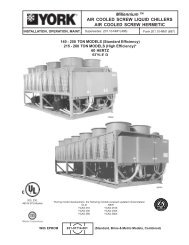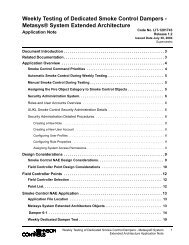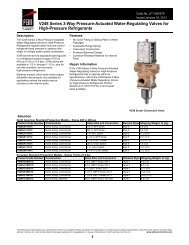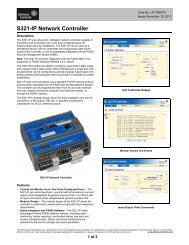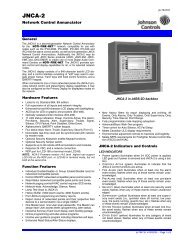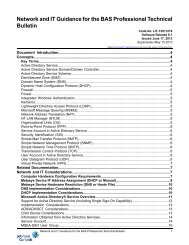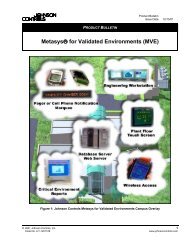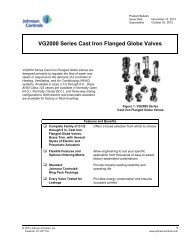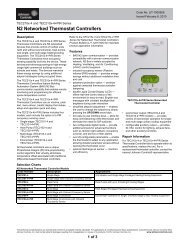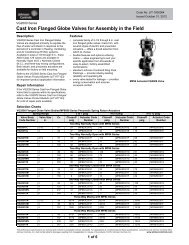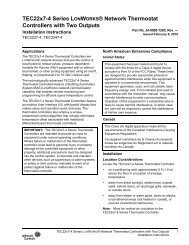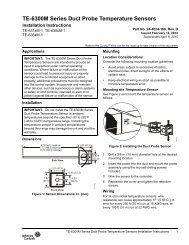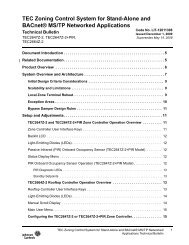YVAA Style A Air-Cooled Screw Liquid Chillers ... - Johnson Controls
YVAA Style A Air-Cooled Screw Liquid Chillers ... - Johnson Controls
YVAA Style A Air-Cooled Screw Liquid Chillers ... - Johnson Controls
Create successful ePaper yourself
Turn your PDF publications into a flip-book with our unique Google optimized e-Paper software.
SECTION 9 - MAINTENANCE<br />
REFRIGERANT REMOVAL, EVACUATION<br />
AND CHARGING A <strong>YVAA</strong> CHILLER<br />
Refrigerant Removal<br />
The <strong>YVAA</strong> utilizes a flooded evaporator. Extreme care<br />
must be taken when removing refrigerant to prevent<br />
damage to the evaporator and the chiller. Carefully review<br />
the following caution below before proceeding<br />
with the recommended process.<br />
130<br />
Incorrect removal of refrigerant will result<br />
in catastrophic freeze damage to the<br />
evaporator and possible additional damage<br />
to other chiller components. Whenever<br />
there is water in the evaporator, the<br />
chilled liquid pumps must be ON and<br />
circulating liquid through the evaporator<br />
above minimum recommended flow rates.<br />
When liquid refrigerant is being removed,<br />
monitor the pressure and do not allow the<br />
pressure to drop below the freeze point<br />
of the chilled liquid flowing through the<br />
evaporator until all liquid refrigerant has<br />
been removed from the evaporator and<br />
only gas remains. Once all liquid has<br />
been removed, the remaining refrigerant<br />
vapor can be removed while allowing the<br />
pressure to drop below the freeze point<br />
with the pump circulating liquid through<br />
the evaporator.<br />
To remove refrigerant from the evaporator, follow the<br />
procedure below:<br />
1. Turn the chilled liquid pump ON and assure the<br />
flow is above the minimum recommended flow.<br />
2. Assure all manual valves in the system are open.<br />
Open Condenser Drain and Economizer Feed<br />
valves to 100% in the service mode.<br />
3. Connect the recovery unit and a manifold gauge<br />
to the liquid line feeding the eductor. There may<br />
be a valve in the line or a Schrader fitting on the<br />
eductor filter for this purpose.<br />
4. Connect the recovery unit to a recovery cylinder<br />
sitting on an accurate scale. Turn the recovery<br />
unit ON and observe the liquid refrigerant flowing<br />
from the line into the cylinder. The flow of liquid<br />
should be obvious.<br />
FORM 201.28-NM1.1<br />
ISSUE DATE: 8/29/2012<br />
5. Monitor the pressure gauge to assure that the pressure<br />
does not drop below the freeze point of the<br />
chilled liquid. Throttle the flow as needed with the<br />
manifold gauge valves to prevent pressures from<br />
dropping below the freeze point.<br />
6. Continue to remove the liquid refrigerant while<br />
observing the flow and the pressure. Note the<br />
charge in the system based on the nameplate data<br />
to determine when the charge removal is nearly<br />
complete. Monitor the weight of the recovery<br />
cylinder to determine when the cylinder is full.<br />
Change the cylinder as needed.<br />
7. Continue removing refrigerant until liquid is no<br />
longer observed flowing in the manifold hoses.<br />
8. Once the liquid is removed and no longer visible<br />
in the hose, the remaining gas can be pumped out<br />
with the recovery unit while the pressure is allowed<br />
to drop to 0 barg (0 PSIG).<br />
9. Servicing may now be performed on the system<br />
as needed.<br />
Evacuating a System<br />
To evacuate a system, follow the procedure below:<br />
1. Turn the chilled liquid pump ON and assure the<br />
flow is above the minimum recommended flow.<br />
2. Assure all manual values are open. Open the Condenser<br />
Drain (Flash Tank Feed) and Economizer<br />
Valves in the Service Mode to 100 %<br />
3. Connect vacuum hoses to as many points as possible.<br />
Be sure that at least one connection is made<br />
on both the high and low side of the piping. A connection<br />
to the evacuation fitting on the compressor<br />
is also recommended. Evacuate the system to<br />
a minimum of 500 microns. Close the valves at<br />
the evacuation points and assure the pressure in<br />
the chiller does not rise more than 50 microns in<br />
10 minutes. Check for leaks if the pressure rises.<br />
Charging Refrigerant into a System<br />
To charge the system with refrigerant, follow the procedure<br />
below:<br />
1. With all system valves open and the Condenser<br />
Drain and Economizer Valves open to 100% by<br />
manually opening them in the Service Mode,<br />
JOHNSON CONTROLS



